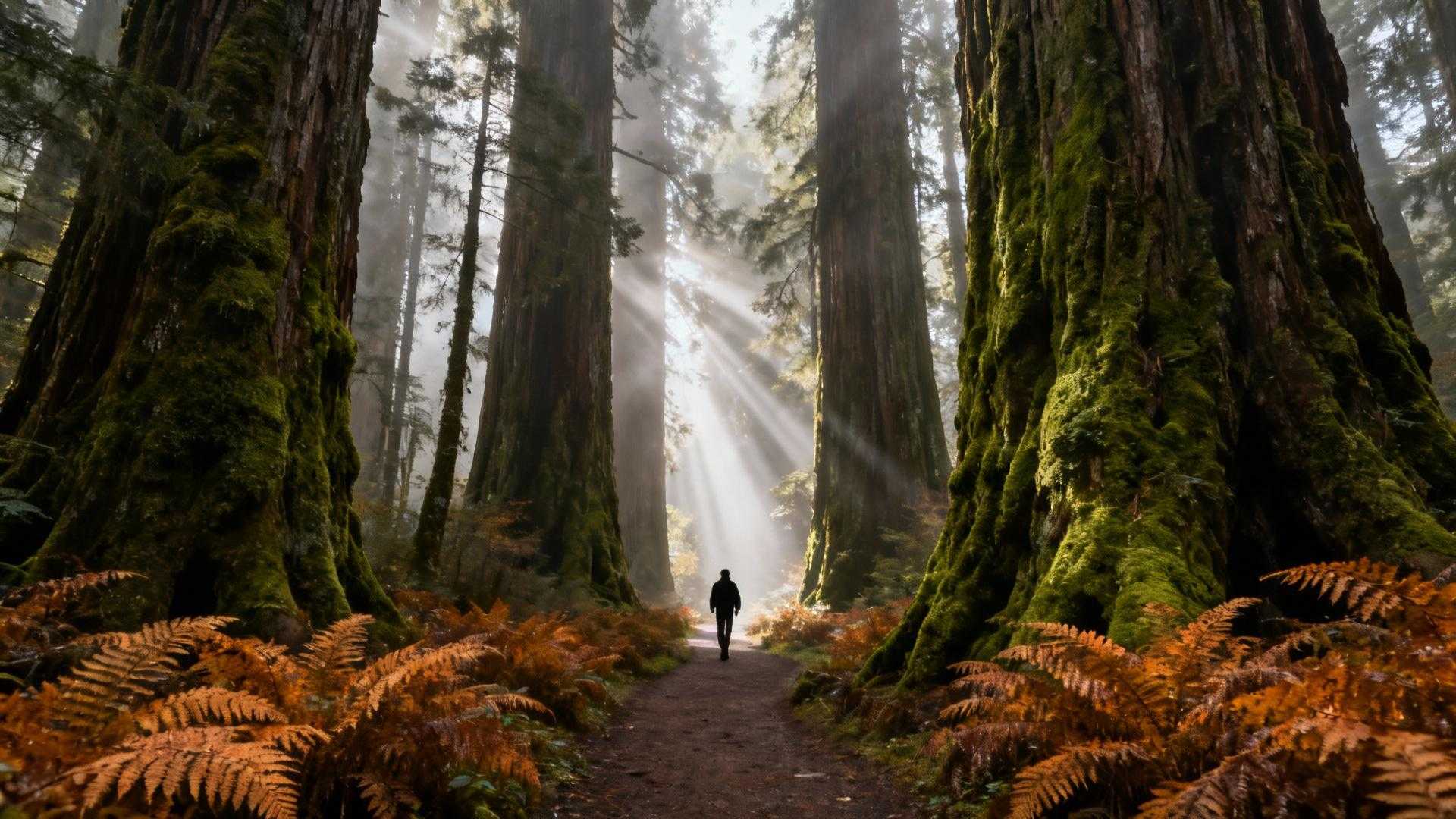I still remember the moment a park ranger leaned across the visitor center counter and whispered: “The world’s tallest tree is within five miles of where you’re standing right now. But I can’t tell you where.” That conversation changed how I understood California’s coast forever. While 4.5 million tourists crowd Yosemite’s parking lots each year paying $35 entry fees, fewer than 500,000 discover this coastal sanctuary where 379-foot giants hide behind a veil of fog and federal protection. This isn’t just another forest. It’s the only place on Earth where coastal redwoods create cathedral groves so tall that UNESCO guards their exact locations like Iceland protects Surtsey Island—where exclusivity serves conservation, not commerce.
The secret coordinates rangers won’t share
Hyperion’s protected location creates ultimate exclusivity
Discovered on August 25, 2006 by naturalists Chris Atkins and Michael Taylor, Hyperion stands as the world’s confirmed tallest living tree at 381 feet—taller than the Statue of Liberty from ground to torch. But here’s what makes this forest truly exclusive: federal authorities actively hide Hyperion’s exact coordinates. Access to the surrounding Crown Jewel grove remains completely prohibited, with violators facing $5,000 fines and six months in jail. This isn’t tourist gatekeeping—it’s ecological preservation. The tree’s fragile root system and surrounding vegetation can’t withstand Instagram pilgrimage traffic.
UNESCO World Heritage status without the crowds
Designated in 1980 under Natural Criteria vii and ix, Redwood National and State Parks protect the largest remaining contiguous ancient coast redwood forest worldwide. These trees represent a 160-million-year-old lineage that once covered moist temperate regions globally but now survives only along North America’s wet Pacific coast. The parks encompass 139,000 protected acres with zero entry fees—while Sequoia National Park charges $35 and battles parking lot overflow. That’s the ultimate California secret: the state’s tallest trees come with the smallest crowds.
Ancient giants with living cultural memory
Yurok-Tolowa indigenous stewardship creates authentic access
In 2023, three federally recognized tribes—the Resighini Rancheria of the Yurok People, Tolowa Dee-ni’ Nation, and Cher-Ae Heights Indian Community—established the Yurok-Tolowa-Dee-ni’ Indigenous Marine Stewardship Area protecting 700 square miles of territorial ocean and coastline. This sovereign initiative means cultural programs here aren’t tokenized tourism—they’re genuine tribal stewardship inviting respectful partnership. Yurok elders lead dawn walks through sacred groves, teaching traditional ecological knowledge passed down through generations who’ve called these forests “Oohl” long before European contact.
2,000-year-old living organisms you can touch
Some coastal redwoods predate the Roman Empire, their massive trunks containing over 550 million leaves and crowns reaching 298 feet in depth. Stand beneath the canopy in Rockefeller Forest’s Bull Creek Flats—the world’s largest contiguous old-growth stand at 10,000 acres—and you’re touching bark that was ancient when Christopher Columbus sailed. Unlike museum exhibits, these living monuments actively grow, capturing coastal fog that provides 40% of their water needs during dry summer months through a climate-dependent ecosystem found nowhere else on Earth.
Insider access that feels like discovery
Tall Trees Grove’s exclusive permit system
While Hyperion remains off-limits, Tall Trees Grove offers controlled access to several of the world’s ten tallest trees through advance permits. The Howard Libby and Paul Zahl redwoods tower here alongside the Nugget—third tallest on record—creating an experience impossible to replicate elsewhere. The permit system maintains ecological integrity while delivering genuine exclusivity. You’ll walk among 370-foot giants with perhaps a dozen other visitors that day, not thousands.
Prairie Creek’s Roosevelt elk convergence
October mornings at 5 AM deliver magic before tour buses arrive: Roosevelt elk graze in meadows surrounded by ancient redwood cathedral groves, their bugling calls echoing through fog-wrapped forests. The elk-redwood convergence exists only here, where 200 miles of trail systems remain refreshingly crowd-free compared to Yosemite’s congested valley loops. Like Croatia’s Plitvice waterfalls that grow 1cm annually, these ecosystems actively build themselves—but redwoods add 24-36 inches yearly, operating at an entirely different temporal scale.
The protection perspective that keeps it pristine
Rangers guard Hyperion’s coordinates not to frustrate visitors, but because uncontrolled access already damaged surrounding vegetation before the 2010 closure. Tribal stewardship programs emphasize “the trees don’t belong to us—we belong to them,” a philosophy that transforms tourism from extraction to reciprocal relationship. Visit during October’s golden window when fog clears but crowds thin, stay on marked trails to protect root systems extending 100 feet from trunk bases, and support Yurok tribal enterprises. This forest’s exclusivity isn’t about elitism—it’s about ensuring these 379-foot living cathedrals survive another 2,000 years for generations who haven’t been born yet.
Essential questions about redwood exclusivity
Why can’t I visit Hyperion if it’s in a public park?
Hyperion’s location remains secret and access prohibited because visitor traffic damages the tree’s fragile root system and surrounding vegetation. Federal authorities enforce this with $5,000 fines and potential jail time. However, Tall Trees Grove offers permitted access to other 370+ foot redwoods, providing an exclusive experience without ecological harm.
How does this compare to other California forests?
Redwood National and State Parks receive 90% fewer visitors than Yosemite (500,000 vs 4.5 million annually) while offering taller trees, zero entry fees, and UNESCO World Heritage status. Coastal redwoods reach 379 feet versus Sierra Nevada’s Giant Sequoias at 275 feet maximum height, though sequoias remain more massive in trunk diameter.
What’s the best time to visit for authentic experiences?
October provides the ideal window: summer crowds dissipate, coastal fog clears for golden light photography, and temperatures hover around 60°F. Visit at 5 AM for Roosevelt elk encounters before tour groups arrive, and explore Rockefeller Forest when most tourists haven’t discovered it exists.
